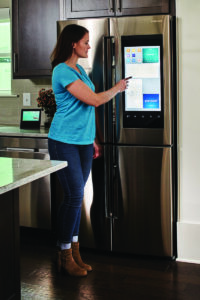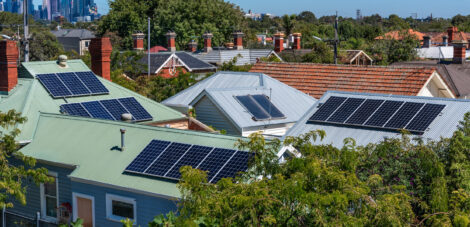Learn about the neighborhood microgrid model to create more localized energy. The Alabama Smart Neighborhood offers an example of microgrids put into practice.
Imagine your house having the ability to ease your morning routine: When your alarm rings, soft-hued light fills the bathroom and illuminates a path to the kitchen, where gentle music streams and a kettle of boiling water sits, ready for tea or coffee. With the swipe of a cellphone app, a smart window in the living room transforms from opaque to transparent, letting in sunrise views. As you leave for work, you speak a single command that locks all doors and activates a security system.
Many of us can envision the Jetsons living in a home with futuristic features like these, but for homeowner Hannah Kennedy, smart home living is a present-day reality.
Kennedy lives not in Orbit City, but in Reynolds Landing, a neighborhood in the Birmingham suburb of Hoover, Alabama. Walking around to admire the handsome new construction and symmetrical lawns, you’d likely not realize that the neighborhood is an experiment in resilient, low-carbon energy, and connected to one of the first community microgrids in the country.

What’s a Microgrid?
Reynolds Landing has a second name that better characterizes the development’s intelligent planning — Alabama Power Smart Neighborhood. When Alabama Power, an electric utility subsidiary of the energy corporation Southern Company, unveiled its Smart Neighborhood in 2018, it switched on a rare neighborhood-scale microgrid as a way to pilot the technology. But while only a handful of community microgrids exist in North America, traditional microgrids have operated around the world for decades.

A microgrid is essentially a miniature version of the electricity grid, complete with a self-contained power plant and energy distribution network that serves a relatively small geographic area. Traditional microgrids power single customers — stand-alone buildings or institutional campuses, such as hospitals and universities — using just about every fuel type, from natural gas and fuel oil to solar and small hydropower. Community microgrids, by contrast, serve dozens of customers in a neighborhood, or thousands in a city district, usually connecting to the primary grid via a substation.
Microgrids of any size offer a range of benefits. Small-scale renewable energy systems are well-suited for microgrid connection, offering clean, low-carbon power. Because the cost of renewables, such as solar photovoltaics, have plummeted over the past five years, many customers can pay lower overall energy costs than they pay for fossil-fueled power, while gaining the ability to sell energy back to the primary grid. Utilities avoid expensive transmission and power plant upgrades, and can use microgrids to stabilize grid operations. Proponents often point to the potential for community microgrids to support local economies through investment in localized energy infrastructure that creates jobs and keeps energy dollars in the community.

Energy Resilience
In the wake of natural disasters and cyberattacks, the resilience that microgrids can offer has garnered serious interest. After Hurricane Sandy hit several northeastern states in 2012, and wildfires devastated large swaths of California and the Mountain West in recent years, many homeowners and business owners remained in the dark for weeks. Following Hurricane Maria in 2017, residents in Puerto Rico remained without power for months. Homeowners and electric utilities alike are realizing that a centralized energy system isn’t well-suited to recovery after a major disaster, and see microgrids as a solution — specifically for their ability to “island,” or disconnect, from the broader energy grid during a catastrophic event.
“Over long distances, a transmission line is super-vulnerable, whether to a natural disaster or a terrorist attack,” says Craig Lewis, executive director of Clean Coalition. Clean Coalition is an energy policy nonprofit that coined the term “community microgrid.”

In island mode, microgrids can run on battery storage to keep lights and heat on, charge cellphones, and power emergency systems. This feat is accomplished by deploying a lot of local renewable energy systems into the targeted microgrid area, and configuring the system so that renewables and battery storage work together to serve critical facilities indefinitely. With the right planning, an individual homeowner using a backup generator can still benefit from a community microgrid. “If you have a finite supply of fuel — and that same fuel tank can be used for a truck or for the generator — there’s huge benefit to being able to reserve the fuel supply for making truck runs,” Lewis says.

Smart Neighborhood: A Community Microgrid in Action
Community microgrids make technological and economic sense for thousands of locations across North America, but financial barriers have kept them from expanding. The project sizes are typically small enough that major energy financiers are uninterested, and smaller investors, such as community banks, have low awareness of microgrids and how to assess their financial risks. In addition to financial barriers, the relative newness of the concept has been a hindrance — few community microgrids exist to demonstrate organizational models.
Alabama Power aims to tackle both barriers with its Smart Neighborhood. The utility-funded the 62-home development as a research project in hopes the high-tech houses could provide a window into how a typical house built in 2040 will operate. “The neighborhood is a living laboratory for us,” says Todd Rath, director of Marketing Strategy, Programs, and Intelligence for Alabama Power. “You can read a million articles about smart homes and microgrids, but we wanted to see these in a real-world setting.”
Signature Homes, the project’s construction partner that built the homes in Reynolds Landing, designed the houses to be 35 percent more energy-efficient than comparable newly built homes in the region. When the homes went up for sale in early 2018 with price tags in the $350,000 to $450,000 range — comparable to new construction of similar size in Hoover — all 62 homes sold within months. Many buyers were drawn to the homes because they offered homeowners better control over their own resource use and carbon footprint: Homeowners can monitor their energy use with an online dashboard. Refrigerator cameras reveal inventory (handy while standing in line at the grocery store); many appliances respond to voice commands using Amazon’s virtual assistant, Alexa; and every garage hosts an electric vehicle charging station.

“We can control our entire house from our phones,” Kennedy said in an interview for the U.S. Chamber of Commerce. “The home is set up to make you consciously think, ‘How much energy am I using? How much water am I using? What are things that I can do to make my energy footprint a lot less?’ “
Kennedy’s efficiency efforts are assisted by her home’s triple-pane windows with remote-controlled shades that contribute to the house’s super-tight envelope. Energy-Star-rated Samsung appliances, including an induction cooking range, dryer, and water-smart washing machine and dishwasher, are among the most efficient in their class. The home’s heating, ventilation, and air conditioning systems, provided by Carrier, integrate with the microgrid using a smart meter that allows for time-of-day adjustments to prioritize run times when electricity rates are least expensive. And if Kennedy is at the grocery store and confirms that she has milk at home? The refrigerator’s note-taking feature will send a phone alert with the jug’s expiration date.
Most of the microgrid components sit about a mile from Reynolds Landing on 5 acres of land, primarily occupied by a 300-kilowatt array of Canadian Solar panels. A 300-kW Samsung lithium-ion battery storage system and a 360-kW natural gas generator round out the energy supply components for a roughly 1-megawatt total capacity. The system is sized to meet the 1⁄3-megawatt peak energy demand from all 62 homes.

“We’re primarily using the solar panels. We’re hardly ever using the natural gas system,” Rath says. He and his colleagues can turn rows of the solar array on and off for testing, and they planned enough energy storage that the neighborhood can run for two hours on batteries alone during the hottest day of summer or the coldest day of winter, and much longer on milder days. They island the microgrid on occasion to gain insight, which resulted in the need to swap out an original transformer that was preventing islanding. “We’re collecting data at the circuit level, and every partner in this project has access to this data,” Rath says.
Alabama Power and its partners plan to use the data from Smart Neighborhood to determine whether the utility can deploy dozens more microgrids in the area. In the meantime, much of the project’s features can be adopted by communities everywhere. Community solar programs are increasingly widespread, and allow neighbors to buy into a local solar agreement as a group. Smart home gadgets are widely available, battery backup technology has greatly improved, and more homeowners are working with their utilities to build resilient energy systems. “What sets the Smart Neighborhood apart,” Rath says, “is bringing all these components into a single, integrated neighborhood tied to a microgrid.”
Plan a Microgrid Project in 6 Steps

A clear framework can reduce microgrid project complexity. Clean Coalition recommends the following pathway aimed at accurately sizing microgrid components and organizing stakeholders from the outset.
- Establish goals. Avoid costly overdesigns by clearly defining the benefits you hope to achieve with a microgrid. Questions to ask include: What are the desired performance metrics, power-backup capabilities, and renewable energy options? Example goals may be to ensure at least 25 percent of electricity comes from renewable sources, or to provide a minimum per-home amount of power during disasters.
- Perform baseline grid analysis. Chart daily and monthly energy load profiles, characterize grid operations, and quantify current energy generation. Also, identify critical loads during an outage event.
- Conduct a renewables siting survey. Survey total renewable energy potential in your area to determine energy storage needs and control systems. For example, conduct a survey to assess potential solar generation of a site using tools such as Google’s Project Sunroof or the National Renewable Energy Laboratory’s (NREL) Resource Assessment.
- Optimize distributed energy resources. Optimizing noncentralized energy sources, such as a solar array, involves marrying Steps 2 and 3, with the end goal of determining baseline power flow and the maximum renewables capacity that won’t require grid upgrades. This step may include creating an electric load forecast, an equipment list, an operation and maintenance schedule, and weather forecasting.
- Complete an economic analysis. Analyze project costs and benefits along with the net value of microgrid activities. Be sure to account for cost reductions in transmission and delivery of the energy, utility and resilience benefits, and for local job creation. Environmental benefits can include greenhouse gas emissions avoided, gallons of water saved, and acres of land preserved.
- Develop a deployment plan. Finalize the system design, financial model, and operational plan. Because you’ll need to match a microgrid’s components to the technologies affordably available in your area, this step may include gathering quotes from qualified vendors.
Kale Roberts is a former MOTHER EARTH NEWS editor and current program officer with ICLEI-Local Governments for Sustainability, where he supports cities across the United States in developing resilience and climate action plans.




